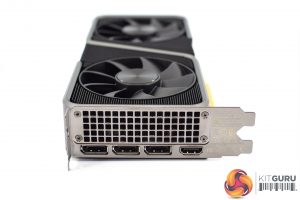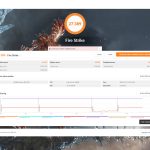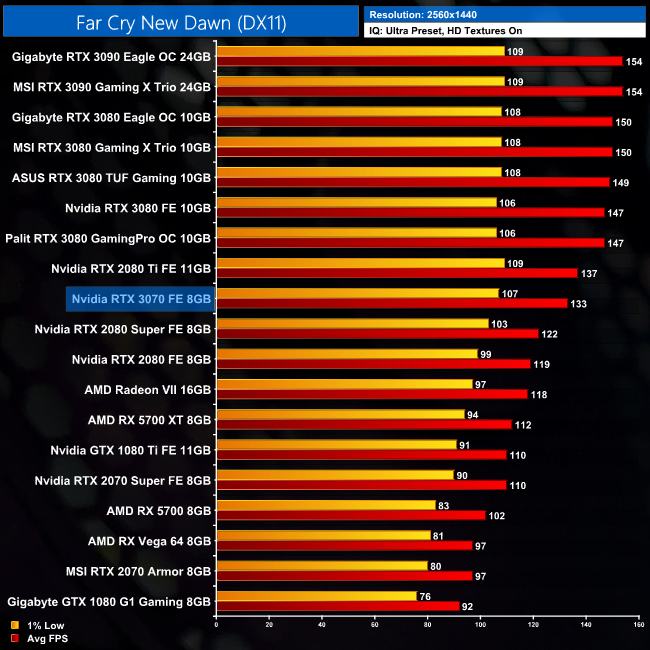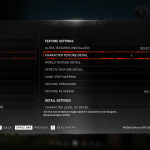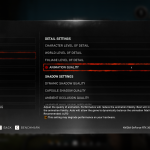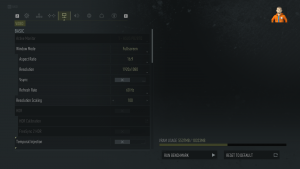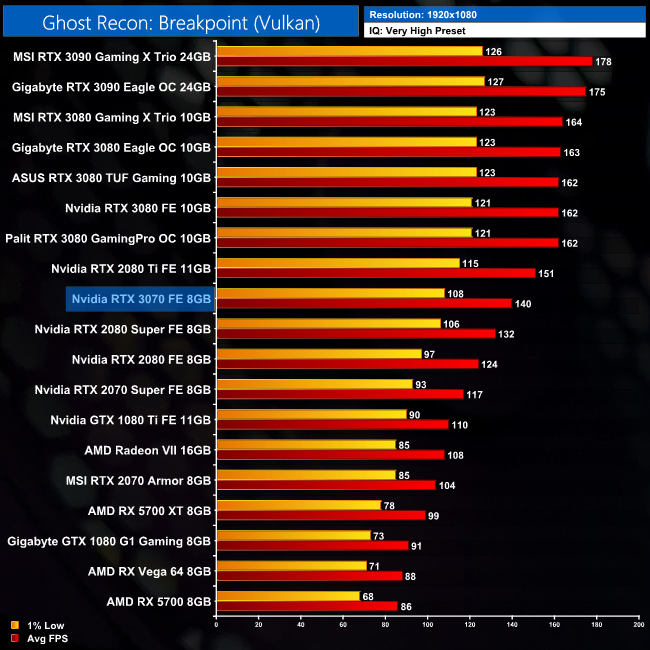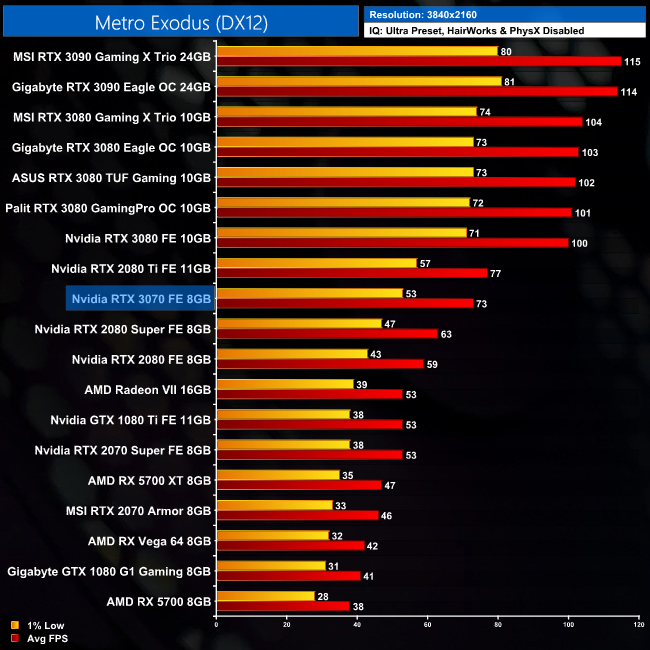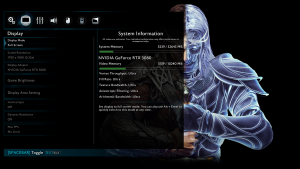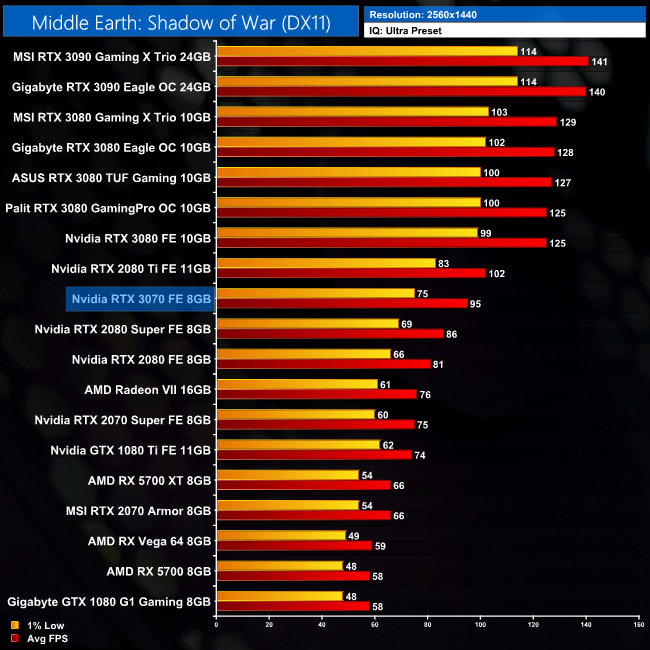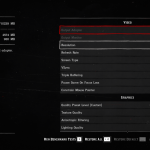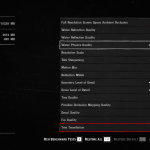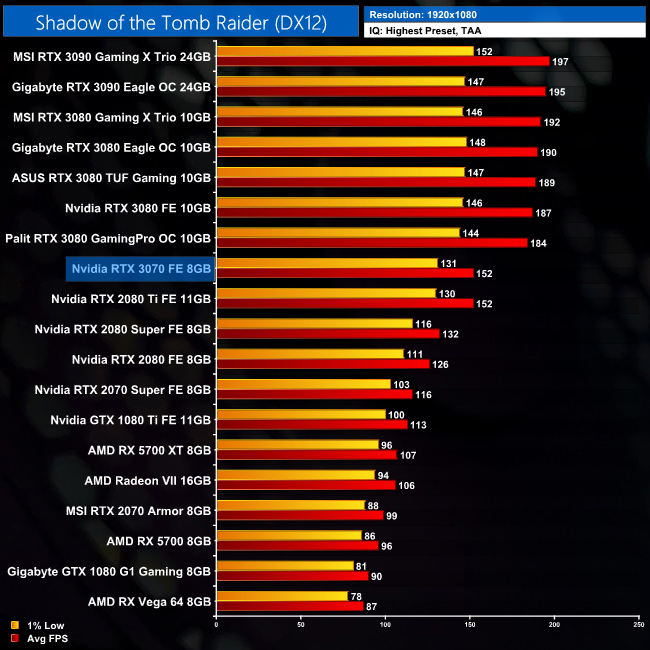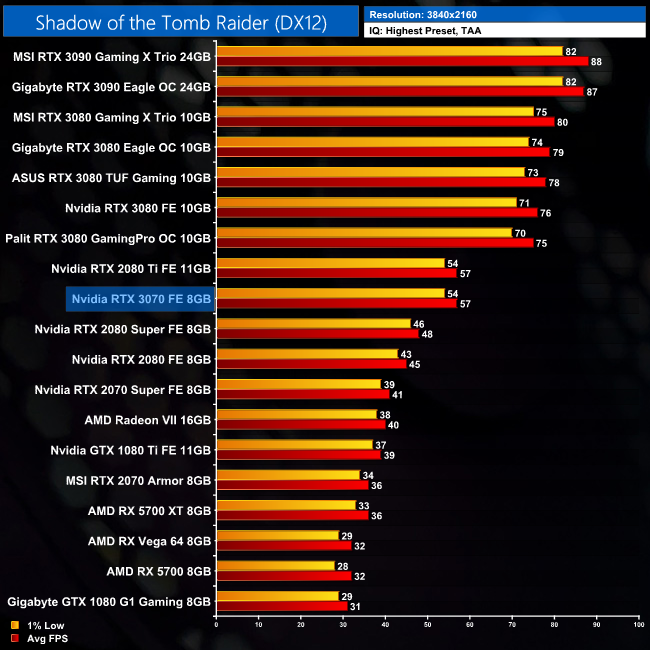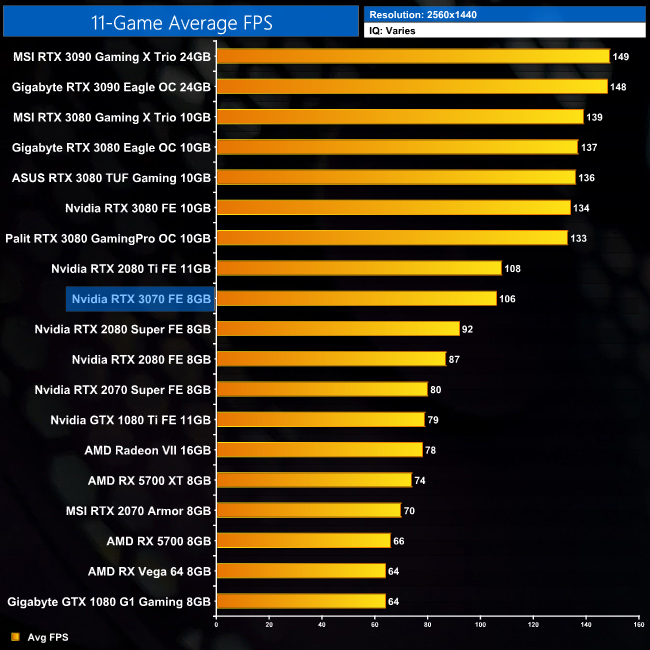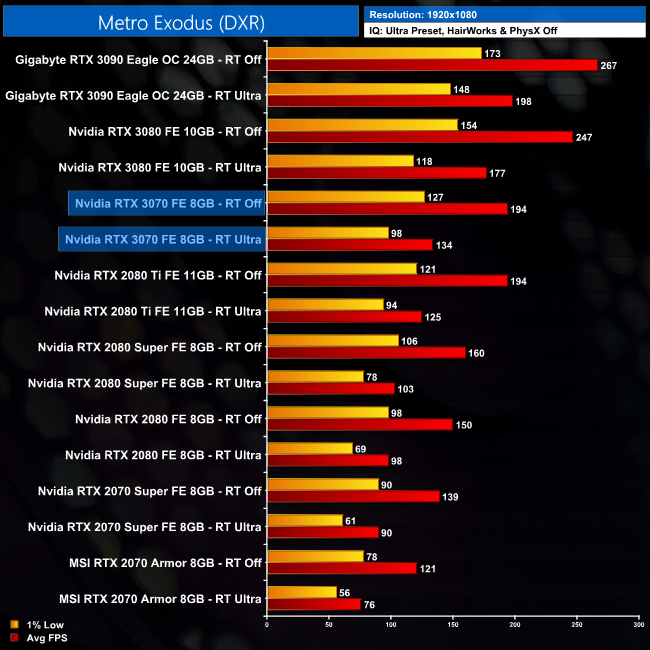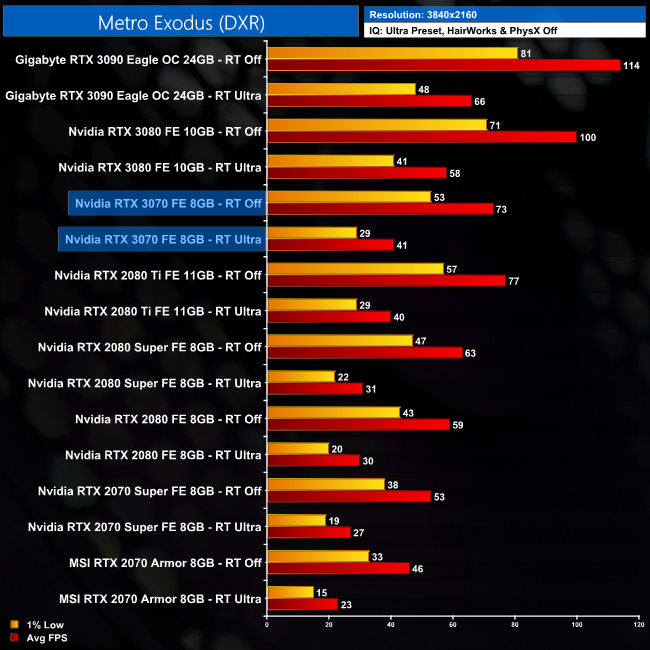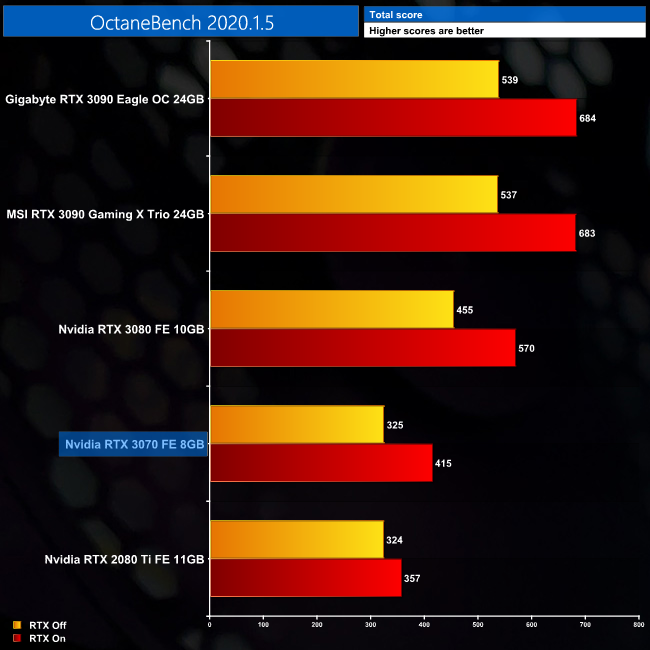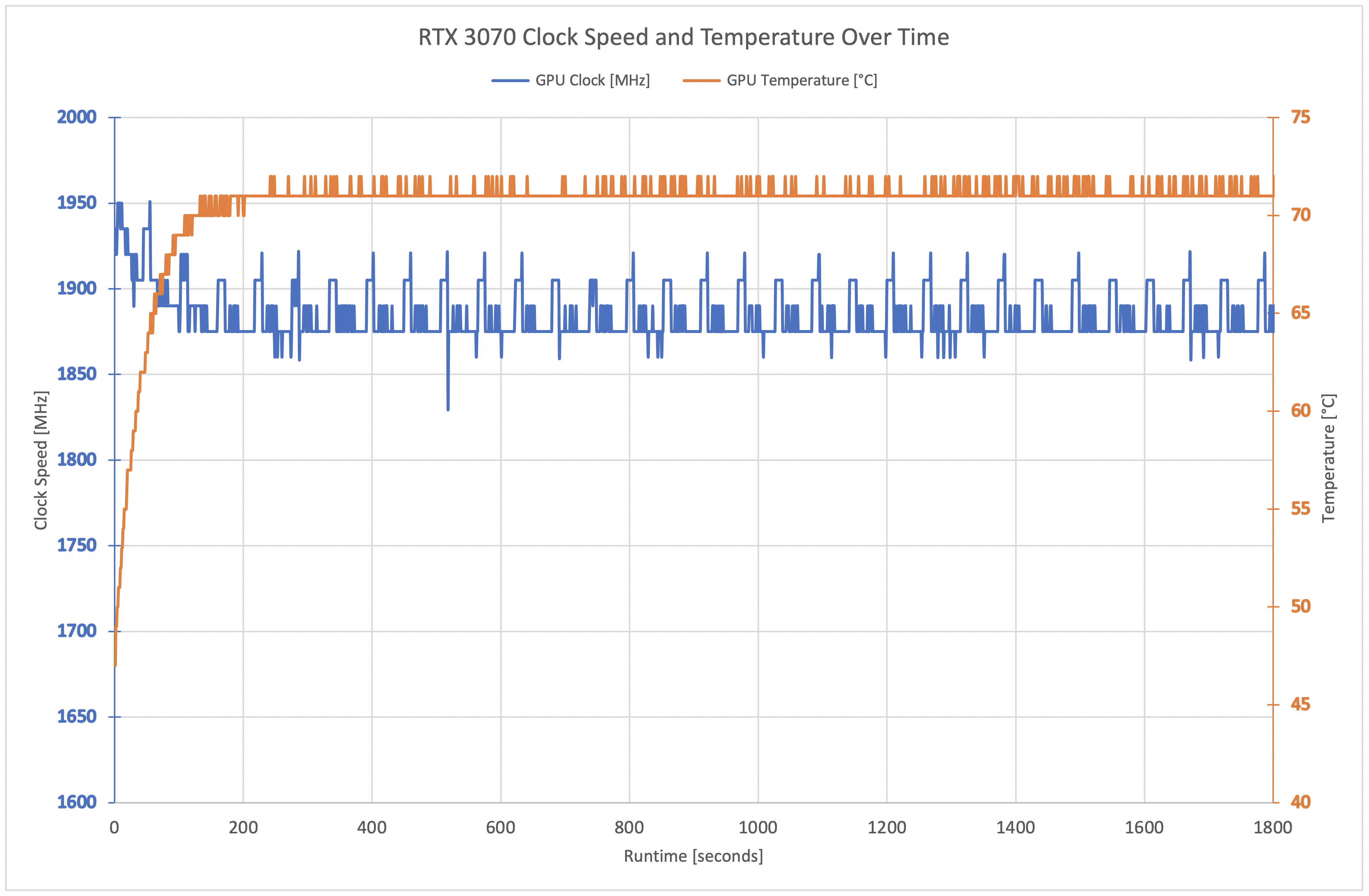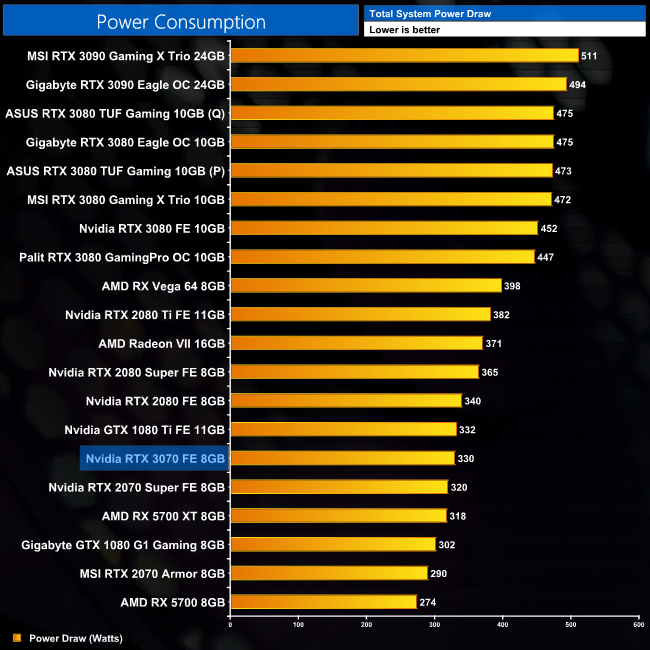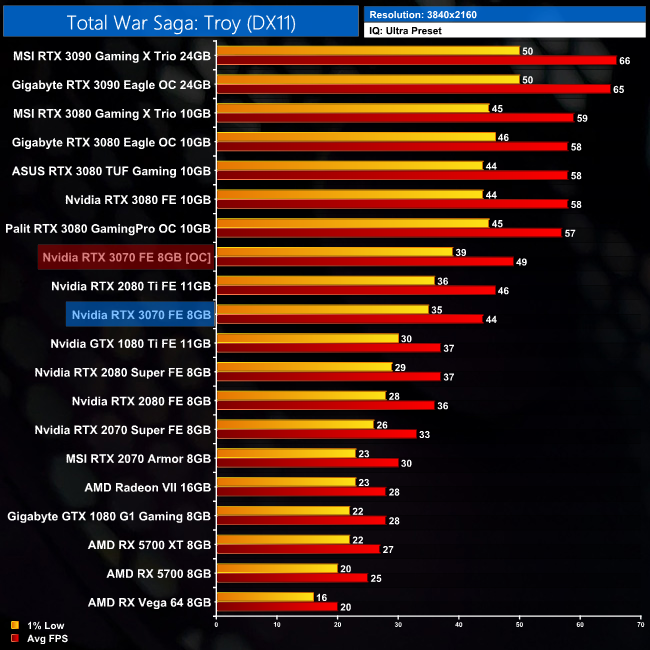
Following hot on the heels of the RTX 3080 and RTX 3090, today we are stepping down the stack with our first look at Nvidia's RTX 3070. Priced at £469 here in the UK, it's certainly not a small investment, but Nvidia will hope this GPU can capture a larger share of the market than the £650 RTX 3080 or the £1399 RTX 3090. Is this graphics card really faster than the RTX 2080 Ti as Nvidia claims?
It's certainly been an interesting launch for Nvidia's new RTX 30-series. RTX 3080 arrived first, and was deservedly praised for offering a huge leap in performance compared to the previous-generation RTX 2080. The RTX 3090 swiftly followed, and while it offered further performance gains for 4K gamers, the high price tag was always going to limit the audience to just the most cash-rich of enthusiasts.
Now, with the RTX 3070, Nvidia is targeting a wider audience thanks to the more accessible £469 price point. I'd hardly call this a ‘cheap' graphics card, but it's the most mainstream Ampere GPU we have seen so far. Nvidia didn't shy away from making some bold claims about this new GPU either, as we heard from Nvidia CEO Jensen Huang that the RTX 3070 is in fact faster than the RTX 2080 Ti, last generation's flagship GPU which sold for over £1000.
| GPU | RTX 3090 | RTX 3080 | RTX 3070 | RTX 2080 Ti (FE) | RTX 2080 SUPER |
| SMs | 82 | 68 | 46 | 68 | 48 |
| CUDA Cores | 10496 | 8704 | 5888 | 4352 | 3072 |
| Tensor Cores | 328 | 272 | 184 | 544 | 384 |
| RT Cores | 82 | 68 | 46 | 68 | 48 |
| Texture Units | 328 | 272 | 184 | 272 | 192 |
| ROPs | 112 | 96 | 96 | 88 | 64 |
| GPU Boost Clock | 1695 MHz | 1710 MHz | 1725 MHz | 1635 MHz | 1815 MHz |
| Memory Data Rate | 19.5 Gbps | 19 Gbps | 14 Gbps | 14 Gbps | 15.5 Gbps |
| Total Video Memory | 24GB GDDR6X | 10GB GDDR6X | 8GB GDDR6 | 11GB GDDR6 | 8GB GDDR6 |
| Memory Interface | 384-bit | 320-bit | 256-bit | 352-bit | 256-bit |
| Memory Bandwidth | 936 GB/Sec | 760 GB/Sec | 448 GB/Sec | 616 GB/sec | 496.1 GB/sec |
| TGP | 350W | 320W | 220W | 260W | 250W |
While it was announced at the same livestreamed event as the RTX 3080 and RTX 3090, we've not heard too much about the RTX 3070 in the intervening period. To recap its core spec, unlike its more expensive RTX 30-series brethren, the 3070 uses Nvidia's GA104 GPU, instead of GA102. GA104 incorporates 46 Streaming Multiprocessors (SMs), and thanks to Ampere's new SM structure with its two FP32 datapaths, each SM houses 128 CUDA cores, giving RTX 3070 a total of 5888.
Ampere also places one RT core, and four Tensor cores, in each SM, giving a total of 46 RT cores and 184 Tensor cores. This is accompanied by 184 texture units, and 96 ROPs which are now housed directly within each graphics processing cluster (GPC), with 16 ROPs per GPC, and 6 GPCs in total for RTX 3070.
Clock speed is slightly higher than the RTX 3080. The RTX 3070 Founders Edition has a reference clock of 1725MHz, and unlike some of the 20-series FE cards, this model is not factory overclocked – Nvidia is leaving that for its AIB partners this time around.
For the memory, here things depart from what we saw with the RTX 3080 and 3090. Gone is Micron's GDDR6X, and we are back to 8GB of 14Gbps GDDR6 memory, operating over a 256-bit bus, for total memory bandwidth of 448 GB/Sec. My particular Founders Edition model uses Samsung G6 memory, but according to Nvidia, RTX 3070 boards will use either Samsung or Micron G6.
Lastly, for total graphics power, Nvidia rates the RTX 3070 for 220W. This is 45W above the RTX 2070, though still 30W less than a reference RTX 2080 Ti, and of course Nvidia is claiming the RTX 3070 is as fast, if not faster, than the 2080 Ti. We will of course be testing that claim today, and seeing just how power efficient this GPU is.
The Nvidia RTX 3070 Founders Edition ships in the same black box as the RTX 3080, with the GeForce branding printed in silver text.
Inside, the small accessory pack consists of a support guide, a quick start guide and a safety note about using ‘third-party power dongles' with the graphics card.
Of course, Nvidia provides its own power adapter, and considering the 3070 has a TGP of 220W, only a single 8-pin connector is required.
The graphics card itself bears significant resemblance to the RTX 3080 Founders Edition in terms of the overall aesthetic, but the cooler layout is different. Where the 3080 placed one fan on the underside and another on the topside, the RTX 3070 uses a more conventional approach, with both fans pushing air from the bottom the card.
The fan on the right hand side still pushes air straight through the heatsink and out of the top of the card, thanks to a large cutout in the backplate. The fan on the left-hand side pushes air up and over the PCB, which should be exhausted out of the case via the I/O bracket. Each fan measures 85mm across. Nvidia also claims its finstack design ‘visually elevates and functionally enhances the airflow-centric design'.
In terms of the overall size of the cooler, Nvidia has managed to shrink the RTX 3070 a fair amount compared to the RTX 3080. Where that card measures 285mm long, the RTX 3070 is 43mm shorter, coming in at 242mm x 112mm, with a standard dual-slot thickness. This also means it is a bit shorter than the RTX 2070 Super FE, which is 267mm long, though the RTX 2070 (non-Super) Founders Edition is smaller still at 228mm long.
On the front side of the card, just like the RTX 3080, we can see the GeForce RTX branding to the right of the power connector. Sadly, this does not illuminate with white LEDs, unlike the 3080.
As for the backplate, it's overall fairly plain to look at, but I quite like that. It's devoid of any logos or branding apart from the words ‘RTX 3070' printed in very small text, with the large cut-out also very visible on the right hand side. As mentioned, this allows the airflow from the fan to pass directly through the heatsink.
Nvidia is once again using its 12-pin power connector with the RTX 3070, and this is placed right in the middle of the card which could make cable management a slight struggle for those who insist on the cleanest-looking PC possible. As with the RTX 3080, though, all of the AIB cards will use traditional 8-pin and 6-pin connectors.
For display outputs, we have 3x DisplayPort 1.4a, and then 1x HDMI 2.1 capable of the full 48Gbps bandwidth.
Driver Notes
- All Nvidia GPUs (except RTX 3000) were benchmarked with the 452.06 driver.
- RTX 3070 was benchmarked with the 456.96 driver supplied to press.
- RTX 3080 was benchmarked with the 456.16 driver supplied to press.
- RTX 3090 was benchmarked with 456.38 public driver.
- All AMD GPUs were benchmarked with the Adrenalin 20.8.2 driver.
Test System
We test using the a custom built system from PCSpecialist, based on Intel's latest Comet Lake-S platform. You can read more about it over HERE, and configure your own system from PCSpecialist HERE.
| CPU |
Intel Core i9-10900K
Overclocked to 5.1GHz on all cores |
| Motherboard |
ASUS ROG Maximus XII Hero Wi-Fi
|
| Memory |
Corsair Vengeance DDR4 3600MHz (4 X 8GB)
CL 18-22-22-42
|
| Graphics Card |
Varies
|
| System Drive |
500GB Samsung 970 Evo Plus M.2
|
| Games Drive | 2TB Samsung 860 QVO 2.5″ SSD |
| Chassis | Fractal Meshify S2 Blackout Tempered Glass |
| CPU Cooler |
Corsair H115i RGB Platinum Hydro Series
|
| Power Supply |
Corsair 1200W HX Series Modular 80 Plus Platinum
|
| Operating System |
Windows 10 2004
|
Comparison Graphics Cards List
- Gigabyte RTX 3090 Eagle OC 24GB
- MSI RTX 3090 Gaming X Trio 24GB
- ASUS TUF Gaming RTX 3080 OC 10GB
- Gigabyte RTX 3080 Eagle OC 10GB
- MSI RTX 3080 Gaming X Trio 10GB
- Palit RTX 3080 GamingPro OC 10GB
- Nvidia RTX 3080 FE 10GB
- Nvidia RTX 2080 Ti FE 11GB
- Nvidia RTX 2080 Super FE 8GB
- Nvidia RTX 2080 FE 8GB
- Nvidia RTX 2070 Super FE 8GB
- MSI RTX 2070 Armor 8GB
- Nvidia GTX 1080 Ti FE 11GB
- Gigabyte GTX 1080 G1 Gaming 8GB
- AMD Radeon VII 16GB
- AMD RX 5700 XT 8GB
- AMD RX 5700 8GB
- AMD RX Vega 64 8GB
Software and Games List
- 3DMark Fire Strike & Fire Strike Ultra (DX11 Synthetic)
- 3DMark Time Spy (DX12 Synthetic)
- 3DMark Port Royal (DXR Synthetic)
- Control (DX12)
- Death Stranding (DX12)
- The Division 2 (DX12)
- Far Cry New Dawn (DX11)
- Gears 5 (DX12)
- Ghost Recon: Breakpoint (Vulkan)
- Metro: Exodus (DX12)
- Middle Earth: Shadow of War (DX11)
- Red Dead Redemption 2 (Vulkan)
- Shadow of the Tomb Raider (DX12)
- Total War Saga: Troy (DX11)
We run each benchmark/game three times, and present mean averages in our graphs. We use OCAT to measure average frame rates as well as 1% low values across our three runs.
3DMark Fire Strike is a showcase DirectX 11 benchmark designed for today’s high-performance gaming PCs. It is our [FutureMark’s] most ambitious and technical benchmark ever, featuring real-time graphics rendered with detail and complexity far beyond what is found in other benchmarks and games today.
Let's kick things off with a look at 3DMark synthetic benchmarks. Here, the performance uplift for the RTX 3070, compared to the RTX 2070, ranges from 49% in Fire Strike, up to 61% in Fire Strike Ultra. Up against the RTX 2080 Ti, we can see small losses in Fire Strike and Time Spy – by 3% and 4%, respectively – before the 3070 nudges ahead in Fire Strike Ultra.
3DMark Port Royal is the world’s first dedicated real-time ray tracing benchmark for gamers. You can use Port Royal to test and compare the real-time ray tracing performance of any graphics card that supports Microsoft DirectX Raytracing. As well as benchmarking performance, 3DMark Port Royal provides a realistic and practical example of what to expect from ray tracing in upcoming games.
Port Royal is the other 3DMark benchmark we look at, as this tests a GPU's ray tracing ability. While we look at this later in the review in more detail, here the RTX 3070 falls short of the RTX 2080 Ti by 6%. Compared to the RTX 2070 though, it's 58% faster in this test.
Control is an action-adventure video game developed by Remedy Entertainment and published by 505 Games. Control was released on 27 August 2019 for Microsoft Windows, PlayStation 4, and Xbox One. (Wikipedia).
Engine: Northlight Engine. We test using the High preset, with 4x MSAA, DX12 API.
Our first game of the day is Control, and this is actually the most demanding title in our test suite. At 1440p, the RTX 3070 averages 75FPS, putting it just 1% behind the RTX 2080 Ti, but compared to the RTX 2070, it comes in significant 56% faster.
As for 4K, the RTX 3070 holds above 30FPS at all times, so it is certainly playable but not the smoothest of experiences. It is, however, exactly a match for the 2080 Ti at this resolution, and holds a huge 65% lead over the RTX 2070.
Death Stranding is an action game developed by Kojima Productions. It is the first game from director Hideo Kojima and Kojima Productions after their split from Konami in 2015. It was released by Sony Interactive Entertainment for the PlayStation 4 in November 2019 and by 505 Games for Windows in July 2020. (Wikipedia).
Engine: Decima. We test using the Very High preset, with TAA, DX12 API.
Death Stranding runs like a charm on pretty much everything, and at 1440p the RTX 2070 averages 133FPS. This gives it a 2% lead over the RTX 2080 Ti, and a handy 51% advantage when compared to the RTX 2070.
4K is no problem for the 3070 in this game either, with the 1% lows coming in just shy of the 70FPS mark. In terms of average frame rates, the 3070 increases its margin of victory to 3% over the 2080 Ti, while it is 57% faster than the 2070 at 4K.
Tom Clancy's The Division 2 is an online action role-playing video game developed by Massive Entertainment and published by Ubisoft. The sequel to Tom Clancy's The Division (2016), it is set in a near-future Washington, D.C. in the aftermath of a smallpox pandemic, and follows an agent of the Strategic Homeland Division as they try to rebuild the city. (Wikipedia).
Engine: Snowdrop. We test using the Ultra preset, but with V-Sync disabled, DX12 API.
Now, in our RTX 3080 review, we noted how The Division 2 was the game that saw the single biggest performance increase for the 3080, when compared to the 2080, and the same applies to the 3070 – at 1440p, it comes in 67% faster than its RTX 2070 predecessor.
Once we step up to 4K, the 3070 still maintains a 67% lead over the 2070, as it averages 55FPS. This puts it exactly on par with the RTX 2080 Ti, with identical 1% lows as well.
Far Cry New Dawn is an action-adventure first-person shooter developed by Ubisoft Montreal and published by Ubisoft. The game is a spin-off of the Far Cry series and a narrative sequel to Far Cry 5. It was released for Microsoft Windows, PlayStation 4 and Xbox One on February 15, 2019. (Wikipedia).
Engine: Dunia 2. We test using the Ultra preset, with the HD Textures pack, DX11 API.
Far Cry New Dawn is heavily CPU limited, even at 1440p. There, the RTX 3070 outperforms the RTX 2070 by 37%, which is the smallest improvement at that resolution across all the games we tested. Compared to the RTX 2080 Ti, it is 3% slower in this title.
At 4K, we become GPU limited and the RTX 3070 falls a little further behind the 2080 Ti, as it is now 5% slower. The lead over the 2070 has grown significantly however, up from 37% at 1440p, to 48% at 4K.
Gears 5 is a third-person shooter video game developed by The Coalition and published by Xbox Game Studios for Xbox One, Microsoft Windows and Xbox Series X. It is the fifth installment of the Gears of War series and the sequel to Gears of War 4. The ultimate edition was released on September 6, 2019, while the standard edition of the game was released worldwide on September 10, 2019. (Wikipedia).
Engine: Unreal Engine 4. We test using the Ultra preset, with Best Animation Quality (instead of Auto), DX12 API.
Gears 5 is another game where the RTX 3070 does well. At 1440p, the GPU hits 100FPS on average, which is a 64% improvement over the RTX 2070, and is even 5% faster than the RTX 2080 Ti. That last result is actually the biggest margin of victory we saw for the Ampere GPU compared to the 2080 Ti, so that definitely gives you an idea of how closely matched these two GPUs are.
At 4K, the RTX 2080 Ti does make up some ground, but the 3070 is still 2% faster at that resolution. It also holds a 63% advantage over the RTX 2070.
Tom Clancy's Ghost Recon Breakpoint is an online tactical shooter video game developed by Ubisoft Paris and published by Ubisoft. The game was released worldwide on 4 October 2019, for Microsoft Windows, PlayStation 4 and Xbox One, (Wikipedia).
Engine: AnvilNext 2.0. We test using the Very High preset, with AA disabled, Vulkan API.
In Ghost Recon: Breakpoint, the relative performance of the 3070 isn't quite so impressive as Gears 5. It's still 44% faster than the 2070 when testing at 1440p, but that is one of the smaller improvements we will see today.
At 4K though, that margin does increase to 51% which is a bit more like it. We can also see the 3070 effectively matching the 2080 Ti, as it is just 1FPS slower in terms of its average frame rate.
Metro Exodus is a first-person shooter video game developed by 4A Games and published by Deep Silver in 2019. It is the third instalment in the Metro video game series based on Dmitry Glukhovsky's novels, following the events of Metro 2033 and Metro: Last Light. (Wikipedia).
Engine: 4A Engine. We test using the Ultra preset, but with Hairworks and Advanced PhysX turned off, DX12 API.
Next up we come to Metro Exodus, which paints a more positive picture for the 3070 than Ghost Recon: Breakpoint. At 1440p, this new Ampere GPU outperforms the RTX 2070 by 58%, as it hits 134FPS on average. This is 3% slower than the 2080 Ti.
As we step up to 4K, the RTX 2080 Ti pulls slightly further ahead – not by a lot, but the 3070 is 5% slower. Compared to the 2070, it is still 59% faster at this resolution.
Middle-earth: Shadow of War is an action role-playing video game developed by Monolith Productions and published by Warner Bros. Interactive Entertainment. It is the sequel to 2014’s Middle-earth: Shadow of Mordor, and was released worldwide for Microsoft Windows, PlayStation 4, and Xbox One on October 10, 2017. (Wikipedia).
Engine: LithTech Firebird. We test using the Very High preset, DX11 API.
In Middle Earth: Shadow of War, we don't see as big of a performance jump for the RTX 3070, but at 1440p it is still 44% faster than the RTX 2070. Incidentally, here it is 7% slower than the RTX 2080 Ti, which is the biggest margin of difference between the two GPUs across all of our testing today.
At 4K, the 3070 does catch up a little when compared to the 2080 Ti, but it is still 5% slower. Compared to the 2070, the Ampere GPU is 46% faster.
Red Dead Redemption 2 is a 2018 action-adventure game developed and published by Rockstar Games. The game is the third entry in the Red Dead series and is a prequel to the 2010 game Red Dead Redemption. Red Dead Redemption 2 was released for the PlayStation 4 and Xbox One in October 2018, and for Microsoft Windows and Stadia in November 2019. (Wikipedia).
Engine: Rockstar Advance Game Engine (RAGE). We test by manually selecting High settings, not using a preset, including TAA, Vulkan API.
Red Dead Redemption 2 is actually pretty similar to Shadow of War in terms of its overall trend. At 1440p, the RTX 3070 is 49% faster than the RTX 2070, but 5% slower than the 2080 Ti.
At 4K, it's still 5% slower than the 2080 Ti, but its lead over the RTX 2070 has risen a little, to 51% when looking at the average frame rate.
Shadow of the Tomb Raider is an action-adventure video game developed by Eidos Montréal in conjunction with Crystal Dynamics and published by Square Enix. It continues the narrative from the 2013 game Tomb Raider and its sequel Rise of the Tomb Raider, and is the twelfth mainline entry in the Tomb Raider series. The game released worldwide on 14 September 2018 for Microsoft Windows, PlayStation 4 and Xbox One. (Wikipedia).
Engine: Foundation Engine. We test using the Highest preset, with TAA, DX12 API.
Our penultimate game is Shadow of the Tomb Raider, which sees the RTX 3070 average over 100FPS at 1440p. This puts it 58% ahead of the RTX 2070, while it is a dead heat with the RTX 2080 Ti.
There's nothing to split between the 3070 and 2080 Ti at 4K either, as both post identical frame rates. Compared to the 2070, the Ampere GPU is still 58% faster at this resolution.
Total War Saga: Troy is a 2020 turn-based strategy video game developed by Creative Assembly Sofia and published by Sega. The game was released for Windows on 13 August 2020 as the second installment in the Total War Saga subseries, succeeding Thrones of Britannia (2018). (Wikipedia).
Engine: TW 3 Engine. We test using the Ultra preset, DX11 API.
Finally we come to Total War Saga: Troy. The gains for the 3070 when compared to the 2070 are a little bit below average here, with a 42% lead for the 3070 when testing at 1440p. This is 6% slower than the RTX 2080 Ti, too.
Lastly, at 4K, the RTX 3070 outperforms the 2070 by 47%. It also closes the gap on the RTX 2080 Ti to 4%, or just 2FPS.
Here we present frame rate figures for each graphics card, averaged across all 11 games on test today. These figures can disguise significant variations in performance from game to game, but provide a useful overview of the sort of performance you can expect at each resolution tested.
Looking at the overall performance figures, the first trend to discuss is how the 3070 stacks up against the 2080 Ti. As we saw, it wins in some games and loses in others, but taken across the 11 games we tested today, RTX 3070 is 2% slower at 1440p and 4K. That's close enough where I'd call the performance essentially identical, and do bear in mind we're comparing the 3070 Founders Edition, which comes at stock clocks, to the 2080 Ti Founders Edition, which is actually factory overclocked.
Then we have RTX 3070 compared to the RTX 2070. This is much more decisive, as the 3070 is 52% faster on average at 1440p, and then 56% faster on average at 4K. The relative gains aren't as big as we saw going from the 2080 to the 3080, but they are still very sizable.
The last thing I want to point out is how much better the 3070 scales at 1080p. Comparing it to the 2070 again, it is 47% faster at 1080p, which isn't a whole lot less than its relative performance at 1440p or 4K. The 3080, on the other hand, is 43% faster than the 2080 at 1080p, but 55% faster at 1440p and 68% faster at 4K. I'd still argue the 3070 is overkill for 1080p gaming, but doesn't lose out on nearly as much performance at that resolution compared to the 3080.
Using the average frame rate data presented on the previous page, here we look at the cost per frame using the UK MSRP launch prices for each GPU.
For our cost per frame data, we have numbers for both 1440p and 4K. In both, the RTX 3070 tops the chart, offering the best value, though it's not miles ahead of the RTX 3080. At 1440p, each frame costs £4.42, which is 9% cheaper than the RTX 3080. Compared to the RTX 2070, though, each frame is 33% cheaper. And then, up against the 2080 Ti, the 3070 offers essentially the same performance, but reduces cost per frame by 56%.
Here we revisit Control, this time testing with the in-game ray tracing effects set to their highest values.
For our ray tracing benchmarks, we start with Control. There's not a whole lot to say here as the overall performance trends don't really change when turning RTX On – the 3070 is still pretty much neck and neck with the 2080 Ti, and at 1440p it out-performs the RTX 2070 by 63% with ray tracing enabled.
Here we revisit Metro Exodus, this time testing with the in-game ray tracing effects set to their highest values.
It's more of the same in Metro Exodus. With ray tracing quality set to ultra, there's basically nothing to split the 3070 and the 2080 Ti. Considering the 3070 is the fractionally slower GPU in this game when RTX is off, this does mean its relative performance is a touch higher when RTX is turned on, but not by much at all.
Here we revisit Shadow of the Tomb Raider, this time testing with the in-game ray tracing effects set to their highest values.
Lastly, we look at Shadow of the Tomb Raider with ray traced shadows at ultra quality. In this game, there's no difference between the RTX 2080 Ti or the RTX 3070, whether ray tracing is enabled or disabled – performance between the two GPUs is identical.
Both Control and Death Stranding support DLSS 2.0, so we test both at 4K with and without DLSS (using the Quality mode). We tested Control with RT set to High, while Death Stranding does not support RT features.
For some final game testing, we also tried Control and Death Stranding with DLSS enabled. Unsurprisingly, nothing has really changed here. In both cases, the RTX 3070 performs on par with the 2080 Ti when DLSS is off, and turning DLSS on doesn't change that overall trend. It still offers a tidy boost to performance though, with an 86% improvement to the frame rates in Control, and a 39% improvement in Death Stranding.
Here we look at a small selection of productivity benchmarks, starting with Blender 2.90 and OctaneBench.
Blender rendering performance is strong for the RTX 3070. Using CUDA, it offers a huge 39% reduction in total render times compared to the RTX 2080 Ti, while it takes 26% longer than the RTX 3080. Using Optix instead of CUDA sees the 3070 reduce the overall render time by 35% when compared to the 2080 Ti.
As for Octane, render performance for the RTX 3070 with RTX Off is bang in line with the RTX 2080 Ti. The RTX 3070 does pull ahead when RTX is enabled, though, with its score increasing by 16%.
Our final productivity benchmarks look at SPECviewperf 13 and V-Ray.
For the three tests we look at in SPECviewperf 13, the RTX 3070 trends slightly behind the RTX 2080 Ti – it's 5% slower in 3dsmax-06, and 16% slower in creo-02. Finally, catia-05 sees effectively no difference between the two GPUs.
Lastly, we come to V-Ray. Here, the RTX 3070 delivers a render score of 462, an improvement of 27% compared to the RTX 2080 Ti.
Here we present the average clock speed for each graphics card while running the 3DMark Time Spy stress test for 30 minutes. We use GPU-Z to record the GPU core frequency during the Time Spy runs. We calculate the average core frequency during the 30 minute run to present here.
Clock speeds from the RTX 3070 Founders Edition are very healthy, and about as stable as we'd expect from a modern Nvidia GPU. The frequency starts off high, peaking at 1950MHz, but settles down after about 3-4 minutes as temperature climbs, and spends the remainder of the stress test just below 1900MHz, with the occasional spike up to 1920MHz.
Taken across the 30 minute run, the GPU averaged 1885MHz, well above the rated boost clock of 1725MHz.
For our temperature testing, we measure the peak GPU core temperature under load. A reading under load comes from running the 3DMark Time Spy stress test for 30 minutes.
Thermally, the 3070 Founders Edition cooler is a definite success. Across our stress test, we saw a peak temperature of 72C, with a steady state result of 71C. This means the GPU is cooler than the 3080 Founders Edition, despite its smaller heatsink and adjusted fan configuration. It will be fascinating to see how solutions from Nvidia's partners, like MSI, Gigabyte and ASUS, can improve on these results.
We take our noise measurements with the sound meter positioned 1 foot from the graphics card. I measured the noise floor to be 32 dBA, thus anything above this level can be attributed to the graphics cards. The power supply is passive for the entire power output range we tested all graphics cards in, while all CPU and system fans were disabled. A reading under load comes from running the 3DMark Time Spy stress test for 30 minutes.
We've established the RTX 3070 Founders Edition runs cool, and it runs very quiet as well. We measured noise output at 38dBa, with the fans spinning at 48%, or 1700rpm. This may not be as class-leading as some of the aftermarket cards we have reviewed, but it is still very easy on the ears and is simply not bothersome while gaming.
We measure system-wide power draw from the wall while running the 3DMark Time Spy stress test for 30 minutes.
We measured total system power draw at 330W during our stress test, which is essentially on par with the GTX 1080 Ti, and only a touch ahead of the RTX 2070 Super. Compared to the RTX 2070, it's about 40W higher.
We also use GPU-Z to measure Board Power (graphics card-only power draw). This is currently only available for Nvidia cards, which is why we have excluded AMD results from the chart. Aside from the fact this is software-based reporting, and not a hardware measurement of the PCIe power cables and PCIe slot (for that we’d need something like PCAT), this should provide us more accurate data to work with as it is measuring only the GPU power, and not total system power which is a fundamentally imprecise measurement.
RTX 3070 has a rated total graphics power value of 220W, and using the GPU-Z Board Power metric, we saw average power draw come in at 216W, so pretty much bang on its rated value. This is 4W higher than the RTX 2070 Super, and 42W above the RTX 2070. Crucially, it is also 42W less than the RTX 2080 Ti, despite offering essentially identical gaming performance.
By using the GPU-Z Board Power data in conjunction with the 11-game average FPS data we presented earlier in this review, we can work out performance per Watt for each graphics card. This is presented as FPS per Watt.
RTX 3070 sets a new standard for performance efficiency, delivering 0.28 FPS per Watt. This isn't miles ahead of the RTX 3080 FE, or even Gigabyte's RTX 3090 Eagle OC, but it does offer 16% higher FPS per Watt than the RTX 2080 Ti. Compared to the RTX 2070, that number increases to 27%.
I wasn't sure what to expect when manually overclocking the graphics card. So far, RTX 3080 and RTX 3090 have proven to be pretty limited overclockers, but I am pleased to say I had much more success with the 3070.
I think part of the reason for that is, by using GDDR6 (instead of GDDR6X) memory, frequencies can be pushed that little bit further before performance degradation would start to happen with G6X. I was able to push the Samsung G6 in the Founders Edition all the way up to 16.2Gbps without any artifacting or instability.
The GPU core also pushed a little further than I've seen from an RTX 3080. I could add +115MHz to the frequency, and saw it boost as high as 2115MHz without crashing. I've not seen close to that from a 3080.
Those adjustments resulted in some pretty decent improvements to our games. Gears 5 saw average FPS improve by 9%, and then we saw both Ghost Recon: Breakpoint and Total War Saga: Troy delivering an extra 11% when overclocked. I have to say this is much more like it, and these gains would be enough for an overclocked RTX 3070 to beat the RTX 2080 Ti in every single game we tested.
After the rip-roaring success of Nvidia's RTX 3080 which launched back on September 16th, the RTX 3090 was met with a more muted reception, mostly because of its incredibly high price tag. Now, with the RTX 3070, Nvidia is firmly back on track and has a very strong GPU on its hands that will offer much wider appeal than the RTX 3090 or even RTX 3080.
Priced at £469 here in the UK, the RTX 3070 was heralded as being faster than the RTX 2080 Ti, but for less than half the price. Based on our testing, that claim is true, but not absolutely conclusively. Of the eleven games we benchmarked today, the RTX 3070 is faster in three of them, and marginally slower or equal to the 2080 Ti in the rest.
Overall, across those eleven games we tested, RTX 3070 is on average 2% slower than the RTX 2080 Ti at 1440p and 4K. At worst, it was no more than 7% slower, and at best no more than 5% faster. In my eyes, the two are effectively as fast as each other, as the differences really are quite trivial. That's excellent performance for a xx70 series GPU though; the RTX 2070 is about 10% slower than the GTX 1080 Ti, so to have this generation's xx70 SKU matching the previous generation's flagship is positive news.
Speaking of the RTX 2070, when compared to this GPU, we can see substantial gains for the RTX 3070. At 1440p, the Ampere GPU is 52% faster on average, and that climbs to 56% at 4K. Compared to the RTX 2070 Super, we're talking gains of 32% and 36%, respectively, and then 36% and 41% when up against the GTX 1080 Ti. As a final comparison, RTX 3070 is 21% slower than the RTX 3080 at 1440p, and 25% slower at 4K.
Those numbers also raise the question as to whether this is a 1440p or 4K card. For me, I'd rather use it at 1440p, ultra settings, with frame rates almost always north of 100FPS. It can do 4K, like the RTX 2080 Ti can, but not at an always-locked 60FPS. In titles like Death Stranding or Far Cry New Dawn, keeping above 60FPS is no problem. More demanding titles like Control or Gears 5, however, will see average frame rates drop below 60FPS, with the 1% lows choppier still.
I also think the VRAM allocation makes most sense for 1440p gaming. 8GB of GDDR6 memory is fine for 1440p ultra settings right now, though at 4K we are starting to see one or two titles eat more than that. More VRAM is always going to be welcome on any particular card, but it's always a balancing act between actual benefit and cost.
With the RTX 3070, Nvidia also saw fit to change the Founders Edition design. This card is about 40mm shorter compared to the RTX 3080, and has both its fans on the underside, instead of one on the topside of the card. As the RTX 3070 is significantly less power hungry than the RTX 3080, though, this new cooler is still more than good enough to tame the 220W Ampere GPU.
Temperatures, for instance, didn't go above 72C during my testing, which means it is actually slightly cooler-running than the bigger RTX 3080 Founders Edition. Noise output is also very easy on the ears, with the two axial fans spinning at 1700rpm under load. We'd still expect custom cards from the likes of ASUS, MSI and Gigabyte to improve on this performance, but the RTX 3070 Founders Edition is a technically excellent piece of engineering.
The improvement the Ampere architecture has made to power efficiency is also more evident with the RTX 3070 than we saw from the RTX 3080. Drawing pretty much bang on 220W under load, this GPU offers 16% higher performance per Watt than the RTX 2080 Ti, and it's even better compared to the RTX 2070, with 27% higher performance per Watt. Again, it's not close to the jump from Maxwell to Pascal, but it is definitely a step in the right direction.
Enthusiasts will be glad to hear that we experienced significantly better overclocking results with our RTX 3070 sample. Right now I can only talk about this Founders Edition card, so it's still not clear whether or not I just got lucky with the silicon lottery, but overclocking this card resulted in performance gains between 9-11%. Compared to the lacklustre overclocking capabilities of the RTX 3080, this is much more positive and means an RTX 3070, when pushed to its limit, should be faster than RTX 2080 Ti in pretty much any scenario.
In sum, Nvidia has delivered an excellent graphics card in the form of its RTX 3070. At £469, this GPU delivers unmatched value for 1440p, and even 4K, gamers. It's about as fast as the RTX 2080 Ti, it is significantly faster than the RTX 2070, while also being more power efficient.
As I write this, we are still waiting for AMD's RDNA 2 event on October 28, and frankly they'd be mad not to have a competing Radeon GPU around this price point. If I had £500 or-so to spend on a new GPU, I'd certainly want to wait and see what Team Red comes up with, but as with the RTX 3080, the RTX 3070 has put Nvidia in a strong position to fend off the AMD threat.
RTX 3070 is set to be available from October 29th, priced at £469 MSRP. Custom cards will also be available from Overclockers UK HERE.
Discuss on our Facebook page HERE.
Pros
- Effectively matches RTX 2080 Ti for less than half the price.
- Upwards of 50% faster than the RTX 2070.
- Current market leader in terms of cost per frame.
- Improved overclocking compared to the RTX 3080.
- Most power efficient GPU we've ever tested.
- Founders Edition is beautiful and runs cool and quiet.
Cons
- Some may be concerned about the 8GB framebuffer.
- RDNA 2 is days away, so some may want to wait and see what AMD has to offer.
KitGuru says: Nvidia has taken some of the RTX 3080 magic and brought it down to a more accessible price point with the RTX 3070. It's still not cheap at £469, but it is the new market leader in terms of cost per frame for 1440p and 4K gaming.
 KitGuru KitGuru.net – Tech News | Hardware News | Hardware Reviews | IOS | Mobile | Gaming | Graphics Cards
KitGuru KitGuru.net – Tech News | Hardware News | Hardware Reviews | IOS | Mobile | Gaming | Graphics Cards













